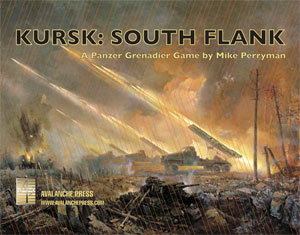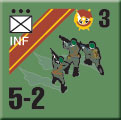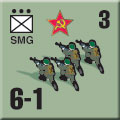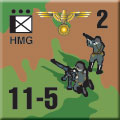South Flank, Burning Tigers:
Blue Skies and Brown Mud
by Mike Bennighof, Ph.D.
February 2022
At some point in my childhood, I’m not sure where and when but I must have been very small, we had a neighbor who was a U.S. Army officer. I don't remember his name or rank, either, but I do recall how the neighborhood kids loved screaming “Why is the sky blue?” at him, just to hear him roar back the answer:
“Because God loves the infantry!”
 As in the real world, foot soldiers are the backbone of the Panzer Grenadier game system. The underlying goal when I designed the game was to make sure it would be just as fun to play, and reflective of history, in scenarios without a single tank or other vehicle on the game board. We’ve managed pretty well on that score; The Kokoda Campaign has no vehicles in any of its scenarios except just one in its very last one, and has been extremely popular. And the basic game rules provided a very solid basis for the Infantry Attacks sister system, in which there are no tanks at all, at least not yet. As in the real world, foot soldiers are the backbone of the Panzer Grenadier game system. The underlying goal when I designed the game was to make sure it would be just as fun to play, and reflective of history, in scenarios without a single tank or other vehicle on the game board. We’ve managed pretty well on that score; The Kokoda Campaign has no vehicles in any of its scenarios except just one in its very last one, and has been extremely popular. And the basic game rules provided a very solid basis for the Infantry Attacks sister system, in which there are no tanks at all, at least not yet.
Our two Kursk games, South Flank and Burning Tigers, are filled with tanks, as you might expect from games based on history’s largest tank battle. The sheets of pieces show row after row of tank drawings, from the tiny Goliath “toy” demolition tanks up to the mighty Tiger. We’ve certainly marketed both games from that angle, but that doesn’t erase the value of the same branch that's won every war since Ramses marched on Kadesh - the infantry. Today we'll take a look at the game's foot soldiers, both German and Soviet.
Infantry
  
German infantry platoons had been re-organized before the 1941 campaign, switching from three squads of 13 each to four squads of 10 men each - at least on paper. That’s not enough to change the game ratings of the standard German INF piece, which has served in every Panzer Grenadier game involving the German Army between 1938 and 1943. Soon after the German defeat at Kursk, the infantry would undergo a much more radical organizational overhaul, with platoons giving up some of their manpower but receiving a higher proportion of automatic weapons in exchange. These are represented by the GREN piece found in games like Elsenborn Ridge or Invasion 1944.
By the time of the Kursk battles (July and August 1943) the Waffen SS had switched from an occupation force flung haphazardly into battle (as in 1941 and 1942) to a front-line combat organization, at least among the divisions committed to the Citadel offensive. South Flank (there are no SS pieces polluting Burning Tigers) reflects this change: the SS infantry are not as powerful as the GREN pieces found in Elsenborn Ridge but much improved from the INF of Sinister Forces. The SCH (Schützen) are a new infantry type, a transitional organization from the old-style SS to that of the late-war years.
  
The Red Army of Workers and Peasants (RKKA) has the standard INF piece that carries it from the 1938 Changkufeng battles through the fall of Berlin and on into the early years of the Cold War. As with the German INF piece, a series of reorganizations took place throughout the war, but not on a grand enough scale to change the game ratings. And as among the Germans, few units actually fielded their paper strength, so a drop in squad size from 11 to nine men doesn't really signify. The same is true for the Soviet Guards, who are rated slightly higher thanks to their better standards of supply and equipment.
The RKKA and Guards also bring SMG platoons armed with the PPsh submachine gun, with higher firepower than the equivalent INF piece but less range. These represent both the dedicated sub-machine gun platoons found in Soviet rifle regiments and the similarly-armed infantry of the tank and mechanized brigades, the feared “tank riders.”
Heavy Weapons
   
The standard German HMG piece soldiers on from 1938 through 1945, though it doesn’t always represent the same thing. In the early years of the war, including the South Flank and Burning Tigers games, the standard HMG piece usually represents a platoon equipped with four MG34 weapons rigged for the heavy machine-gun role (on a tripod, with plenty of extra barrels and ammunition). In the last years of the war, it's a section of two or three of the much deadlier MG42, also in heavy machine gun mode.
The Waffen SS pick up a much more lethal piece, as the Czech-made weapons found in Sinister Forces give way to the MG42. The SS piece is more powerful than the equivalent Army unit, but is less common in scenarios as the SS spread their weapons into the rifle platoons on a greater scale than was true of the Army.
On the Soviet side, the Maxim M1910 soldiers on in the standard Soviet machine-gun platoon found in every game ranging from 1938 through 1945. As with the Germans, the HMG pieces also include the firepower of light mortars (50mm or 60mm).
Engineers
 
Soviet intelligence operations had picked up the German intent to attack at Kursk, but as effective as these were they were also almost un-needed: the Germans telegraphed their intention with lengthy preparations and numerous delays. By the time the offensive finally jumped off, the Soviets had erected powerful fortifications in their path and assembled copious reserves.
The German engineer platoon went through just as many organizational changes as its infantry counterpart, but not enough to alter its game ratings. The same pieces are present from 1938 to 1945, but in the Citadel game there are more of them than usual as the Germans tried to compensate for the Soviet fortified lines by deploying more combat engineers to breach them. And as with their infantry, the Waffen SS engineers are finally reaching the standards of the Army units.
On the Soviet side, combat engineers were of course present at the battle but take no part in either game’s scenarios. Despite the massive achievements of the Five Year Plans, the Soviet people had not yet overcome the legacy of tsarism and relatively fewer men had the technical schooling or factory experience to serve as engineers, compared to the recruit pool found in industrial societies like Britain or Germany. The Red Army therefore had a smaller engineering establishment, and most commanders had a definite reluctance to risk them in infantry combat.
So that's who fights on the ground in the combined 80 scenarios of South Flank and Burning Tigers.
Click here to order South Flank right now!
Click here to order Burning Tigers right now!
Kursk Package
Kursk: South Flank (boxless)
Kursk: Burning Tigers (boxless)
Retail Price: $169.98
Experience Price: $135
Gold Price: $108
You can experience the Kursk Package right here.
Sign up for our newsletter right here. Your info will never be sold or transferred; we'll just use it to update you on new games and new offers.
Mike Bennighof is president of Avalanche Press and holds a doctorate in history from Emory University. A Fulbright Scholar and NASA Journalist in Space finalist, he has published a great many books, games and articles on historical subjects; people are saying that some of them are actually good.
He lives in Birmingham, Alabama with his wife, three children, and his Iron Dog, Leopold.
Want to keep Daily Content free of third-party ads? You can send us some love (and cash) through this link right here.
|
